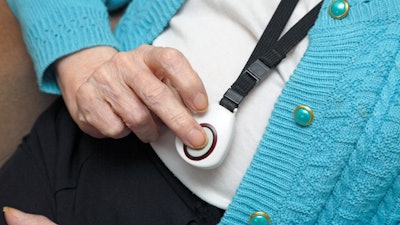
Caring for seniors poses unique challenges, and not just because of the pandemic. In addition to normal healthcare needs, care providers have had to adapt to protect seniors from the virus. With networks of friends and family members unable to visit, nurses and family caregivers have worked overtime to meet the needs of seniors.
And one technology in particular has made it possible to limit interactions and monitor the health and safety of seniors at home or in care facilities remotely, mobile personal emergency response systems (mPERS). However, the transition to 5G mobile technologies could soon pose a threat to these devices.
mPERS can describe a variety of different types of devices from watches to pendants to small simple function phones. What makes these devices unique is they all feature an easy-to-use SOS button that a senior can press in case of emergency to reach a family member, caregiver, medical provider or even an emergency call service that can respond to the event.
Some mPERS devices also have fall detection capabilities that can automatically trigger a call for help. And thanks to cellular connectivity, these personal emergency response systems that used to just be a speaker box and pendant that could only function within the home, are now mobile and able to provide protection anywhere.
For now, that is.
As telecom providers prepare to upgrade networks to new 5G capabilities and remove 3G services, some of these devices may become obsolete. Many panic button devices were designed using 3G or even 2G and EDGE technologies because the data being transferred by the device doesn’t require the higher speeds of a 4G network, let alone 5G.
As networks are upgraded, 2G and 3G devices could lose coverage and become less reliable. This is because telecom companies will be trading out the 2G and 3G technologies on cell phone towers for faster 4G and 5G technologies. Panic buttons operating on 2G or 3G networks will not be compatible with the new network speeds and their functionality could experience drops in coverage in areas where 2G and 3G coverage no longer exists.
For example, Verizon eliminated its 3G networks at the end of 2020, and AT&T is working through a plan to sunset 3G by 2022. Ericsson, an information communication technology company that installs 5G technologies on cell phone towers, predicts that by 2023 twenty percent of the world’s population will have 5G coverage. While the cellular upgrades will infinitely speed up heavy data transfers like streaming video, the problem that exists for the mPERS industry and end users is that 4G and 5G devices have yet to be widely introduced to the mass market.
The basic functionality of panic button devices has not required rapid advancement of the technology that powers their operation. This and other factors affecting the mPERS industry have resulted in a device drought and slow efforts to upgrade older 3G mPERS devices. Now, manufacturers are forced to catch up with changing networking standards in order to continue to provide the safety and peace-of-mind customers rely on from their devices.
Families and medical professionals who rely on mPERS devices to ensure the safety and well-being of their family members or patients need to know if the devices will become unreliable as network upgrades are made. This can be accomplished by contacting the device manufacturer or the company providing monitoring services for the device. If it is discovered that devices are operating on 2G or 3G networks, it would be wise to upgrade the mPERS devices as soon as possible.
For existing devices that are in use in care facilities or patients’ homes, implementing a regular testing schedule to ensure the devices are operational and have coverage is imperative. Weekly, devices should be triggered to ensure that SOS messages are being transmitted. This simple test would only take a few seconds and would quickly determine if backup safety measures need to be taken or if the panic buttons are reliable.
Users may find that mPERS devices being used in more rural areas will continue to have 2G or 3G coverage, while those in urban areas will lose coverage sooner. This is simply because of the tendency for telecom companies to upgrade towers in urban areas with dense populations and large business centers first.
Transitioning from 2G or 3G panic buttons to 4G devices could come with an added cost. But it is an essential upgrade to ensure ongoing protection and monitoring companies may be offering incentives to support the transition. New mPERS devices can also do more than monitor for falls, identify locations and place emergency SOS calls.
These new devices can also be capable of monitoring heart rate, ECG, temperature and other vital signs that can support improved remote patient monitoring (RPM), creating opportunities for improved proactive care. As the aging care industry grows, mPERS will play a crucial role, and these latest upgrades are just the beginning of these devices' potential.
Chris Holbert is the CEO of SecuraTrac.






















